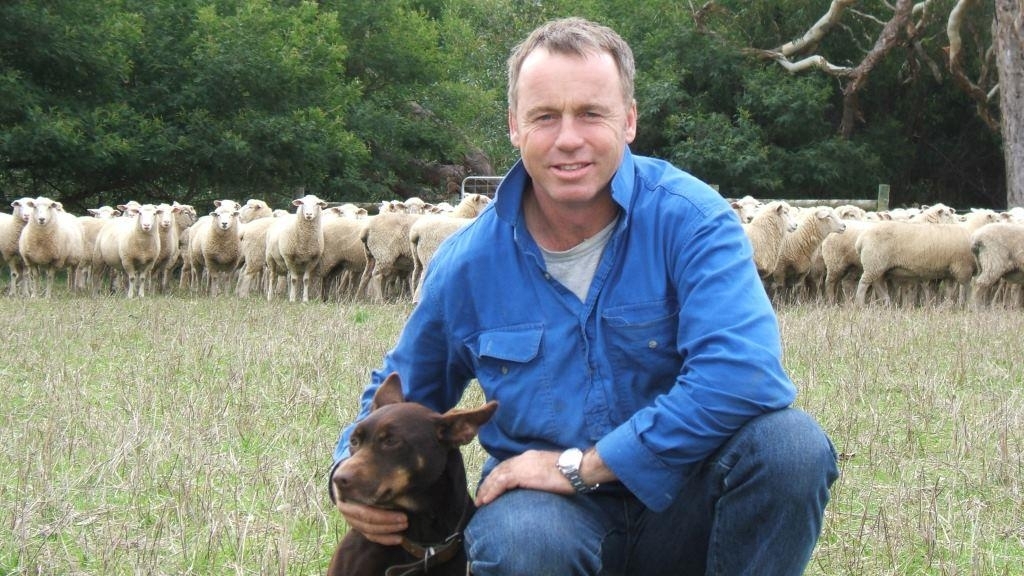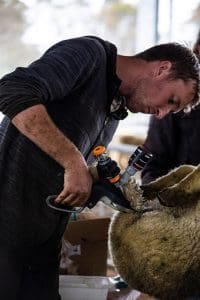
Pigeon Ponds sheep producer Tim Leeming. Picture – MLA.
AUSTRALIA’S sheep and prime lamb producers need detailed cost-benefit comparisons of pain relief options for on-farm surgical procedures, according to south-west Victorian producer Tim Leeming.
The Pigeon Ponds farmer and regional chairman of the Southern Australia Livestock Research Council (SALRC) said detailed cost-benefit, production, animal welfare and market comparisons of the pain relief product, lamb marking and breech modification options were needed.
He is concerned if the cost-benefit comparisons are not done, producer uptake of effective pain-relief options, and appreciation of their production, animal welfare and market implications, might suffer.
The comparisons should include analysis of hot knife use in tail-docking, the new Numnuts lamb-marking system and of the latest alternative to mulesing, liquid nitrogen application or ‘steining’.
Tim Leeming and his wife Georgie run a self-replacing prime lamb flock, maternal sheep seedstock business, with some cattle and a cereal pasture crop program at Pigeon Ponds in western Victoria.
What is best for the sheep and the producer?
Mr Leeming said a key reason he wanted more information on effective pain relief and system options was to inform producers should the market require a reduction or disallowance of hot knife use for tail-docking in the future. Several gas-heated knives or lamb detailers are marketed to Australian and New Zealand producers for tail-docking as an option to rubber rings.
Although it might be argued that use of a hot gas knife for tail-docking might involve less subsequent pain, Mr Leeming believes the practice is unnecessary and “a very bad visual”. Hot knife use would also require added pain relief cost and it created an open wound in a usually unhygienic environment, he said.
“It would be safe to say that 100 percent of lamb marking environments are unhygienic.
“To have an open bloodied wound in those scenarios is just lunacy,” Mr Leeming said.
“It (hot knife use) is not justified if we can provide, four, six or 12-hour pain relief to those lambs and get a ring on their nuts and tails.”
Although personally opposed to the use of a hot gas knife for tail-docking, Mr Leeming said there has been some CSIRO research comparing the pain relief options for tail-docking using this tool and other pain relief options for mulesing.
“I want what’s best for the sheep and for the farmer in the circumstances they run their sheep.”
Comparison of Numnuts costs and benefits needed

Keith Quail uses a Numnuts tool to put a ring on a Leeming lamb last year.
The Leemings stopped mulesing sheep in 1995 and have been working toward making all on-farm sheep operations “bloodless”. He said a lamb-marking option like Numnuts is “perfect for us, the sheep and for consumers.”
The Numnuts system involves the injection of the local anaesthetic NumOcaine via a handheld device that dispenses a rubber ring for tail-docking and castration. The Leemings were among the first producers to field test Numnuts in 2018, docking and castrating about 1200 lambs.
Mr Leeming said Numnuts worked really well, eliminating visual signs of pain and enabling quicker processing of lambs and movement back to paddocks with their mothers without delays or mismothering. But despite being well-designed, he “wouldn’t be putting his name to it (Numnuts)” for full endorsement, until all the options were evaluated.
“It is 75 cents or more by the time you give two shots to a wether and one to a ewe.”
Mr Leeming has had the estimated costs of the other pain relief options with normal ring application quoted to him, but these figures need to be fully verified and documented, and able to be compared by sheep producers wanting to achieve the best low-cost and most effective pain-relieving system.
Numnuts research is currently being extended into more on-farm commercial trials and uptake of the steining process is also being expanded. But Mr Leeming said any research and development of a sheep operation, even in the pain relief area, is “destined to fall on its arse” if farmers decide there is a cheaper option.
“It would be nice to have a specific prime lamb specific pain relief evaluation of all products and all operations.
“We need to measure things like mismothering, travel time back to the paddock from the yards – these little add-on things and the costs will make or break those products.”
He said the cost of associated disease risk with different tail-docking methods and tail lengths under varying pain relief regimens should also be looked at. He quoted the work of New South Wales veterinarian Dr Joan Lloyd, who found lambs with shorter tails (one or two coccygeal vertebrae) had a higher risk factor for bacterial arthritis than those with longer tails (three or more coccygeal vertebrae). Her project also revealed correlations between arthritis and grass seed infestation, and with pleurisy/pneumonia in sheep.
“We need to know and we need to know the costs and we need to enable producers to make a very accurate decision on the use of products that best fit their environment and operation.
“And then we can move towards an industry not cutting the tails off lambs.”
Click here to read the recent Futureye report ‘Commodity or Sentient Being? Australia’s shifting mindset on farm animal welfare’, which found that 80 percent of respondents to a wide-ranging survey on animal welfare believed that performing painful procedures without pain relief was not acceptable.
Range of pain relief products available
Sheep pain relief products available to producers include Tri-Solfen, Australia’s only unrestricted on-farm anaesthetic combination solution for surgical mulesing, tail docking and castration in sheep. It is not yet registered for pain relief treatment on shearing cuts and other accidental wounds.
Troy Laboratories’ S4 Ilium Buccalgesic OTM product is a non-steroidal anti-inflammatory drug able to be used by sheep producers for mulesing, castration and tail-docking after veterinary consultation.
Boehringer Ingelheim’s pain-relieving product Metacam 20 is approved for anti-inflammatory use in sheep and can also be administered to lambs by a farmer or sheep contractor after directions on use by a veterinarian.

Cutting tails off lambs should never be done. You will have more flies and it’s not a good look. Mulesing crossbred lambs is ridiculous. We never take lambs out of the paddock they lamb in for lamb marking. It’s not all about pain relief; it is also about keeping stress to a minimum. Our lambs only away from their mothers for a maximum of an hour and a half. Pain is only for 20 minutes. After that I don’t think pain relief would work or is warranted on crossbred lambs.